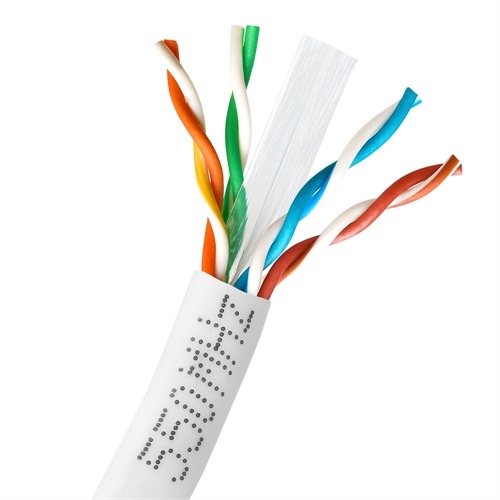Overview of Cat6 Cables
Overview: Cat6 cables are the most advanced cables utilized to connect computers and network devices to each other and to patch panels. They consist of pairs of twisted cables within a single jacket. Cat6 cables are most commonly used in gigabite Ethernet networks and other high-speed applications, because of their high bandwidth/low cross-talk capabilities.
Computer networks continue to become faster and more efficient. That has led to an increased need for extremely high-quality connecting cables which are capable at operating at very high speed and bandwidth, transferring more data much more quickly. The solution: Cat6 cables (also known as Category 6). Cat6 cables are the fastest Ethernet cables currently on the market, and an important upgrade over the commonly-used Cat5e cables for several reasons:
- Cat6 cables operate at a nominal 250 MHz (more than twice as fast as the nominal 100 MHz for Cat5e) and can operate at peaks as high as 500 MHz.
- Cat6 cables can easily transfer data at speeds of 1 gbps and can even transfer as fast as 10 gbps (peak Cat5e data transfer can be ten times as slow).
- Cat6 twisted cables usually have more twists per inch than Cat5e and often have a nylon spline inside and/or a thicker outside sheath, both of which work to reduce alien crosstalk (AXT) and near-end crosstalk (NEXT) in order to guarantee data integrity in “noisy” environments.
- For these reasons, Category6 cables have become the standard for gigabit Ethernet, fast Ethernet and 10-gig Ethernet networks. Importantly, they are backward compatible with Cat5, Cat 5e and Cat3 cables, so there’s no problem mixing them into a network during a slow upgrade process. Cat6 cables are also used in the transmission of video and telephone signals as well as for security systems.
We sell “patched” Cat6 cables, which are optimal for covering relatively small distances because they can be thinner than “unpatched” versions – making the patched cables less expensive to manufacture and purchase.
Cat6 cables are somewhat more costly than their Cat5e counterparts because of their higher capacity and reliability (and the way that they’re constructed). For many applications such as connecting between a hub and a desktop computer, Cat5e would certainly be sufficient. However, the cost differential isn’t enormous – and considering the fact that data transmission speeds and network efficiencies continue to increase rapidly, it makes more sense to opt for the Category 6 category cable if at all possible. That’s because there’s little danger that Cat6 cabling will become obsolete at any point in the near future, unlike Cat5e cables; and as previously mentioned, Cat6 cables are fully backward compatible so they’ll work just fine with all of your other network panels and equipment.
Cmple RJ45 Ethernet LAN Cat6 cables are extremely high quality and extremely affordable. They come in the widest variety of lengths and colors you’ll find anywhere, with lengths ranging from 1.5 to 100 feet. The cables are all stranded CCA (copper clad aluminum) wire with nylon splines in a PVC jacket and terminated in molded connectors, all built for durability.
Our selection of Cmple Cat6 cables provides the ultimate in speed, bandwidth and data integrity, at terrific prices.




